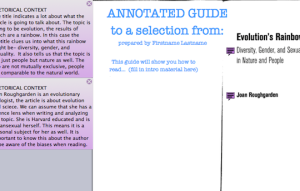Common Teaching Issue:
Students could use more help reading academic articles
I notice this problem in two ways: in how students respond to articles as assigned readings and in how they use academic articles as sources. In either case, what seems clear to me is that many students don’t understand how or why academic articles are put together the way they are, which leads to confusion and frustration as well as a tendency to “hunt for quotes” rather than taking the author’s full position into account.
My solution
I ask students to use annotation tools to mark up readings in PDF format, focusing on these areas: article anatomy, rhetorical moves, critical thinking questions, key ideas, and reading strategies. The annotations take the form of comment bubbles in the margin, with each area given its own color.
Initially the activity is a learning opportunity for students, as they learn to identify each of these areas themselves and come to understand their function. But then I ask them to turn their annotations into a reading guide for lower-division students, so that they begin thinking about how to teach someone else to read an academic article.

Benefits
- Students gain more insight into how academic articles are put together than I was ever able to teach using other methods, like asking them to do summaries or rhetorical analyses
- Students are motivated by the idea that their reading guides might actually be used by lower-division students
How-To
Browse the PDFs tag archive for resources on working with PDF files as well as examples of annotated articles.
